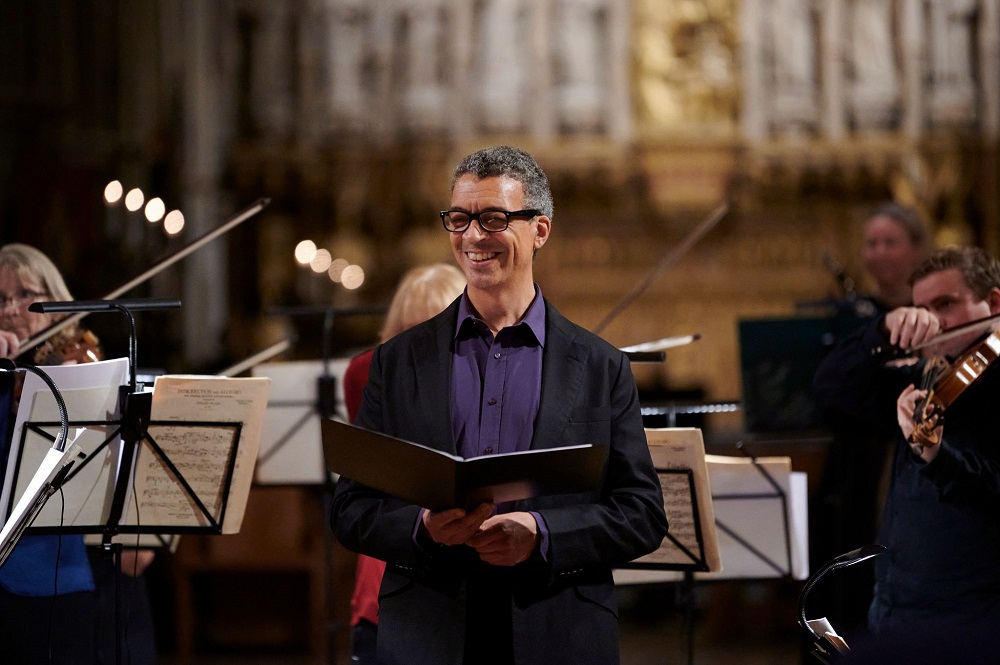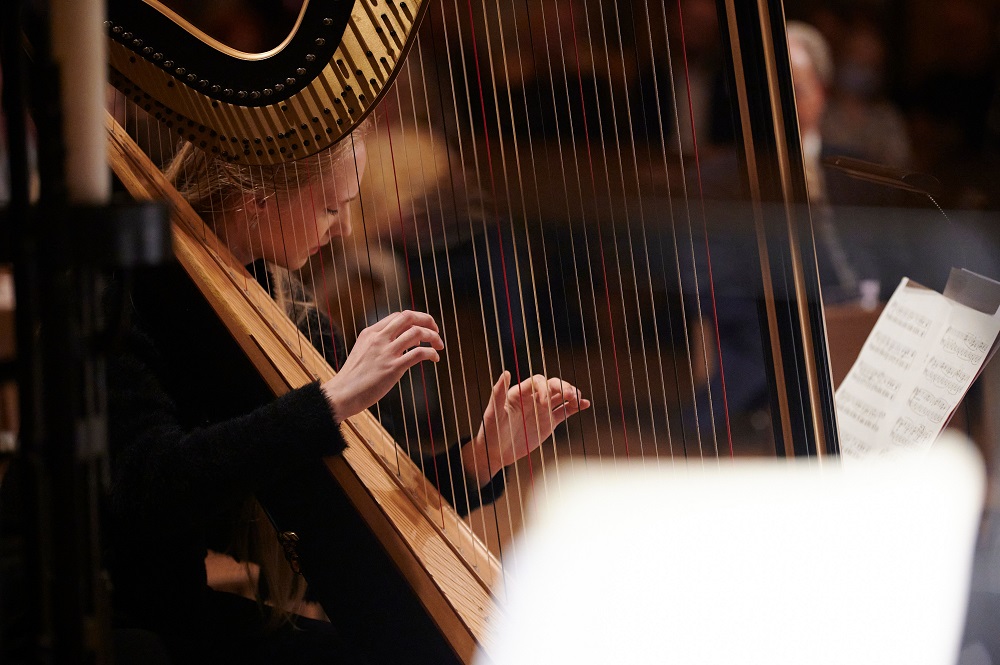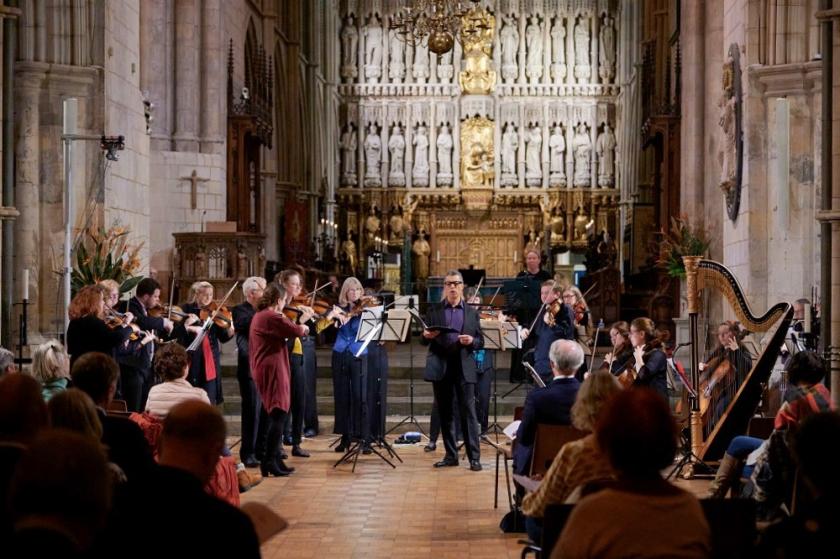A year ago, the City of London Sinfonia’s quietly different concerts in Southwark Cathedral were a lifeline in the twilight of semi-lockdown; I’ll never forget how we treasured the last, on 17 November, knowing that everything would be closed again the following day for at least a month (there was a brief intermission, then darkness again until this May).
Now that the London concert scene is back at full strength, CLS has once again proved, this time in its 50th anniversary season, that it’s still doing something unique at the very highest level, here presenting a fabulously varied programme of works of all shapes and sizes with their roots in the British isles.
Two intervalless hours flew by. The first 20 minutes or so were devoted to a CLS speciality: encouraging the audience to promenade around the cathedral along with the resident cat, picking up a drink, perhaps, at the bar in the retrochoir (sacrilege!), stopping to catch the wisdom of selected players (plus Roderick Williams, the very distinguished but always affable baritone soloist and composer-arranged, pictured below) offering insights into the works they’d be playing. I was held for the duration by cellist Joely Koos, demonstrating how Sally Beamish’s Gala Water deconstructed a Scottish folksong to make it range the depths and height of the instrument’s range, how angry it gets before the tune is properly heard at the end (Beamish composed it for her cellist husband, Robert Irvine, after the tragedy of a miscarriage). The mini masterclass, which included singing from Koos' well-trained voice, enriched the experience of the moving performance later in the evening.  Strings reassembled, viola player Fiona Bonds walked in playing the Welsh lullaby “Suo Gân”, a premonition of another borderland folksong Elgar worked into his Introduction and Allegro, a masterpiece of the repertoire for those forces into which the players then so dramatically plunged (if it weren’t so titled, might it not work best as the ne plus ultra at the end of a programme?) Under the leadership of violinist Alexandra Wood, the CLS took it at quite a lick, dazzling in the more machine-like transitions, maybe needing a conductor’s rubato for the main theme which takes wing in the Allegro.
Strings reassembled, viola player Fiona Bonds walked in playing the Welsh lullaby “Suo Gân”, a premonition of another borderland folksong Elgar worked into his Introduction and Allegro, a masterpiece of the repertoire for those forces into which the players then so dramatically plunged (if it weren’t so titled, might it not work best as the ne plus ultra at the end of a programme?) Under the leadership of violinist Alexandra Wood, the CLS took it at quite a lick, dazzling in the more machine-like transitions, maybe needing a conductor’s rubato for the main theme which takes wing in the Allegro.
From collective to the first of the solos, James MacMillan’s From Galloway, played from the west end of the cathedral by that consummate clarinettist Katherine Spencer with a vibratoish vocal quality at times, but going beyond the ken of any singer in pitch and tone. Wood delivered Gerald Barry’s Triorchic Blues from the other end of the building, sounding like two violins rather than one – a typically offbeat transcription by the composer of the piano original. Butter
The first batch of songs, arrangements from the folk originals by Vaughan Williams and further elaborated for strings by our baritone, didn’t always best suit the cathedral acoustic in the faster numbers – solo strings might have been a help here – but the wistful beauty of “”She’s Like the Swallow” and the haunting narrative of “O Who is That That Raps at My Window”, enhanced in this version, cast a spell. It lasted throughout Williams’ approach as orchestrator to six of Butterworth’s songs setting poems from Housman’s A Shropshire Lad. The addition to strings of harpist Elizabeth Bass (pictured below), who’d just beguiled us in Maxwell Davies’s Farewell to Stromness, made all the difference elaborating the long, effortlessly sustained phrases of “Loveliest of Trees”. But the ultimate hold-your-breath moment came in the ghost-voice harmonics of Watson and Koos backing the plaintive questioning from beyond the grave, awesomely conjured by Williams, in “Is my team ploughing?”  Lively and pensive spirits alternated in the last two works. If there’s been a more bracing world premiere than Huw Watkins’ Five Duos,however modest its scale and scope, I haven’t been present at it. Watkins composed it especially for Wood and Spencer “whose playing,” the note told us, “he has known and loved for over 20 years” The fluid rhythmic fun and games of the outer duos, as brilliant as the rhythmic intricacy of John Adams while sounding nothing like him, made it difficult to sit still – the option to roam and jig about would have been well taken here – while the little mysteries provided more haunting. Our violinist and clarinettist’s collaboration was a joy to watch, too, and the combination meshed brilliantly in the cathedral.
Lively and pensive spirits alternated in the last two works. If there’s been a more bracing world premiere than Huw Watkins’ Five Duos,however modest its scale and scope, I haven’t been present at it. Watkins composed it especially for Wood and Spencer “whose playing,” the note told us, “he has known and loved for over 20 years” The fluid rhythmic fun and games of the outer duos, as brilliant as the rhythmic intricacy of John Adams while sounding nothing like him, made it difficult to sit still – the option to roam and jig about would have been well taken here – while the little mysteries provided more haunting. Our violinist and clarinettist’s collaboration was a joy to watch, too, and the combination meshed brilliantly in the cathedral.
I’d forgotten how world-class and first-rate is Holst’s St Paul's Suite, written for the Hammersmith school where he taught for nearly 30 years. In amongst the fun and games come the passionate augmented seconds of an oriental melody – why? No note I’ve consulted explains or even mentions its unexpected presence, but we know Holst’s affinity for things Indian – ravishingly played here. There was an interesting bit of mini bell-ringing during the "Ostinato" - the perambulating cat decided to have a scratch before a door mysterously opened to help it away from the hurly-burly. The Suite was rounded off by the most brilliant fusion of Tudor melodies "Tthe Dargason" and "Greensleeves", setting the seal on a whole evening with traditional tunes as its bass-line.













Add comment